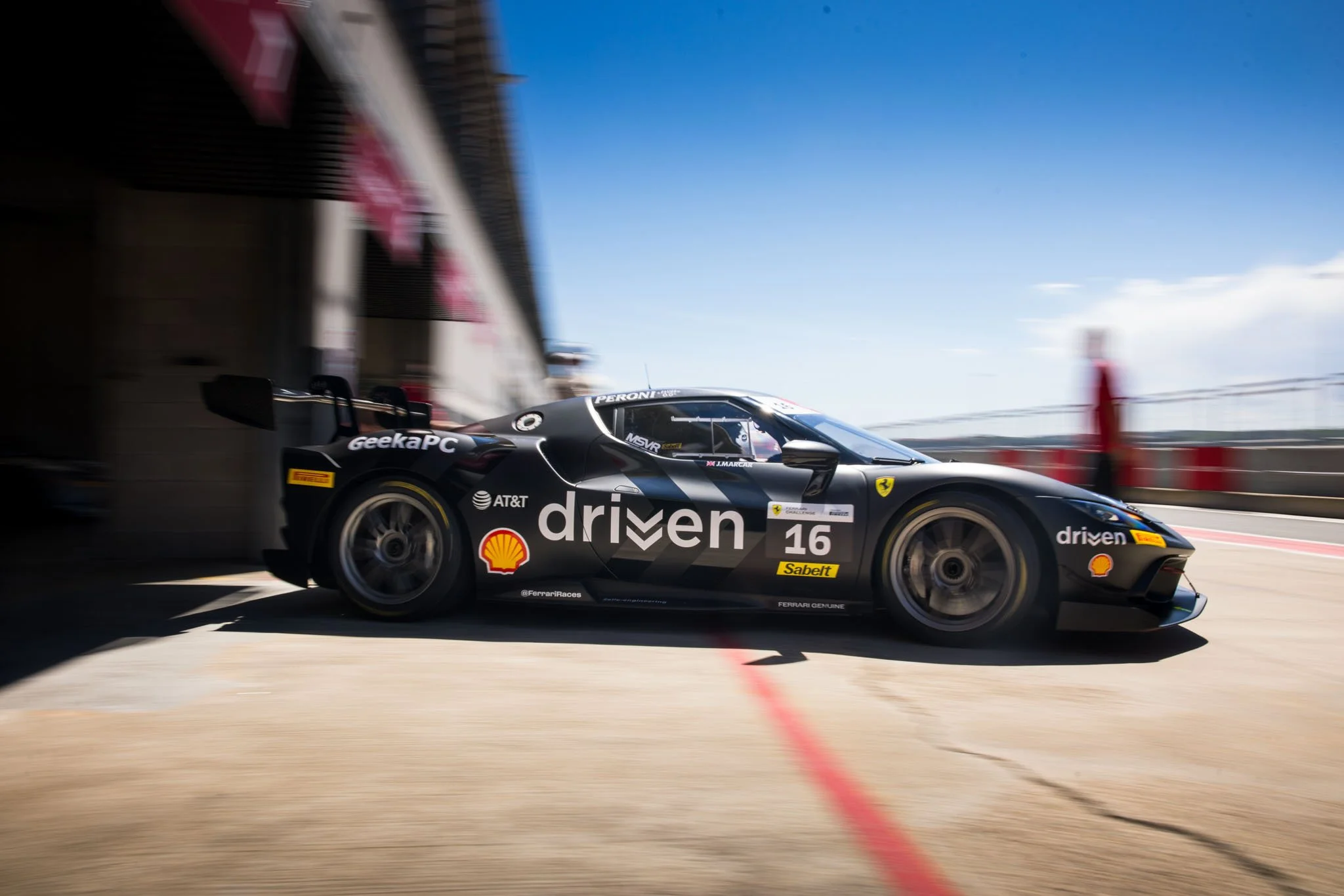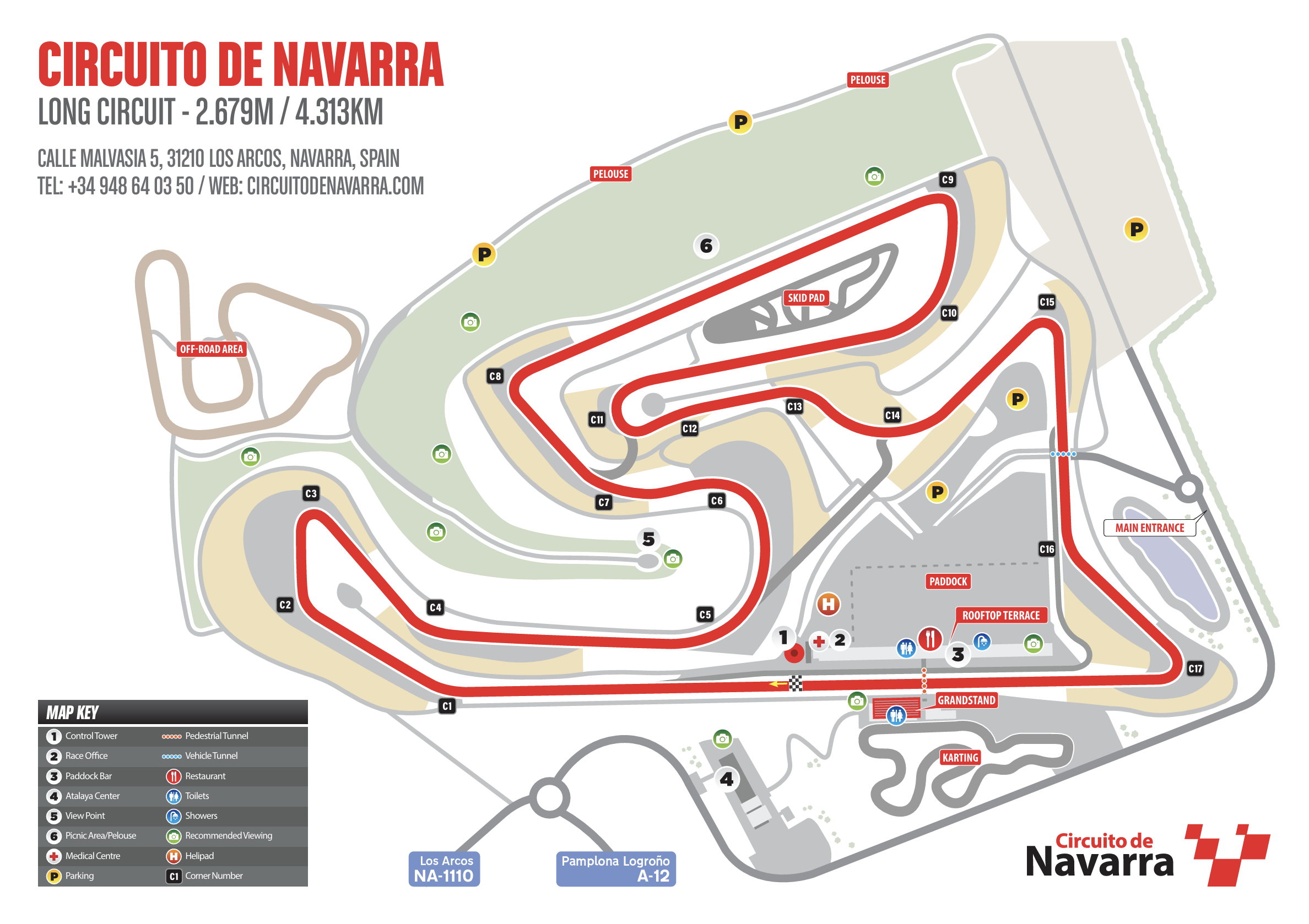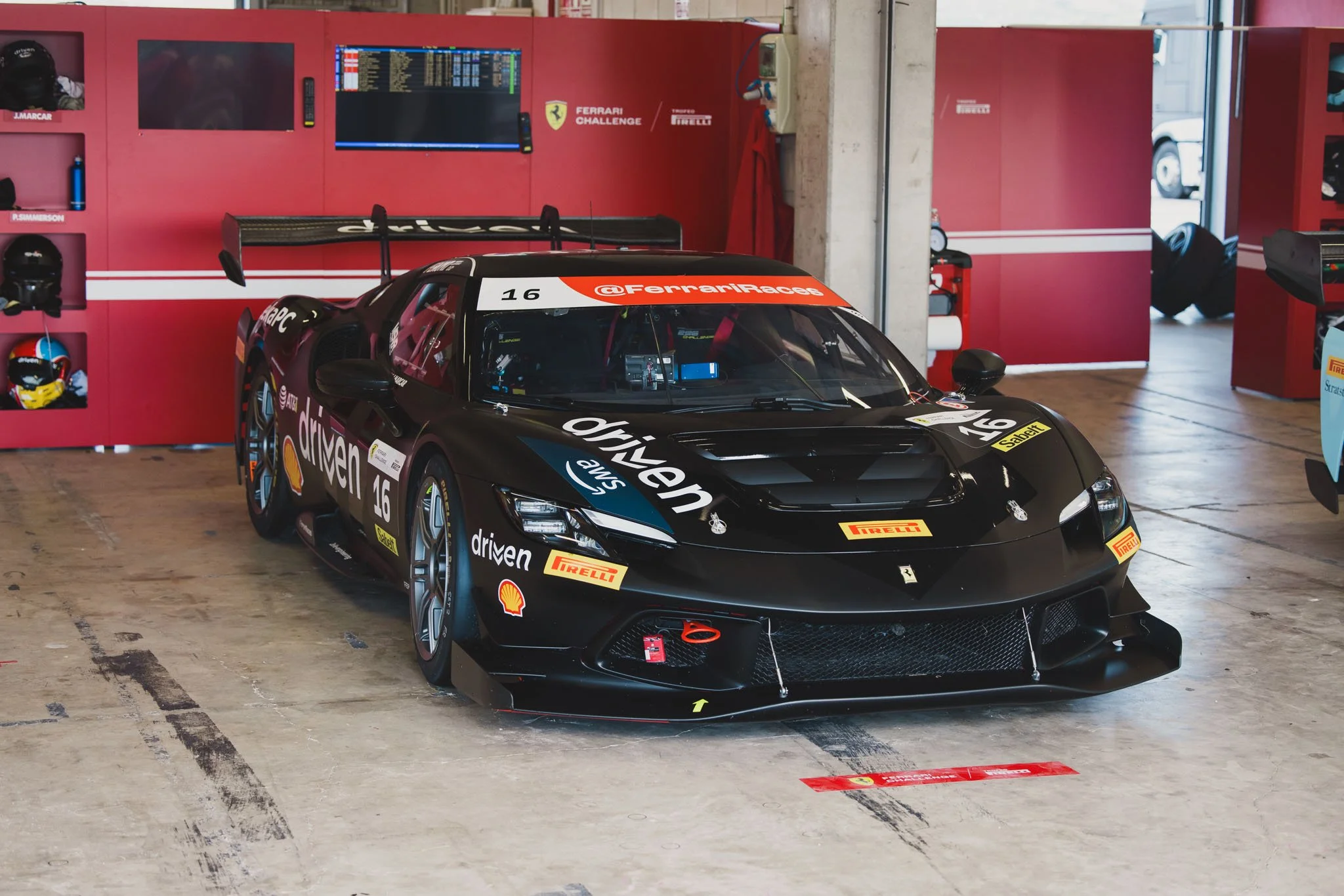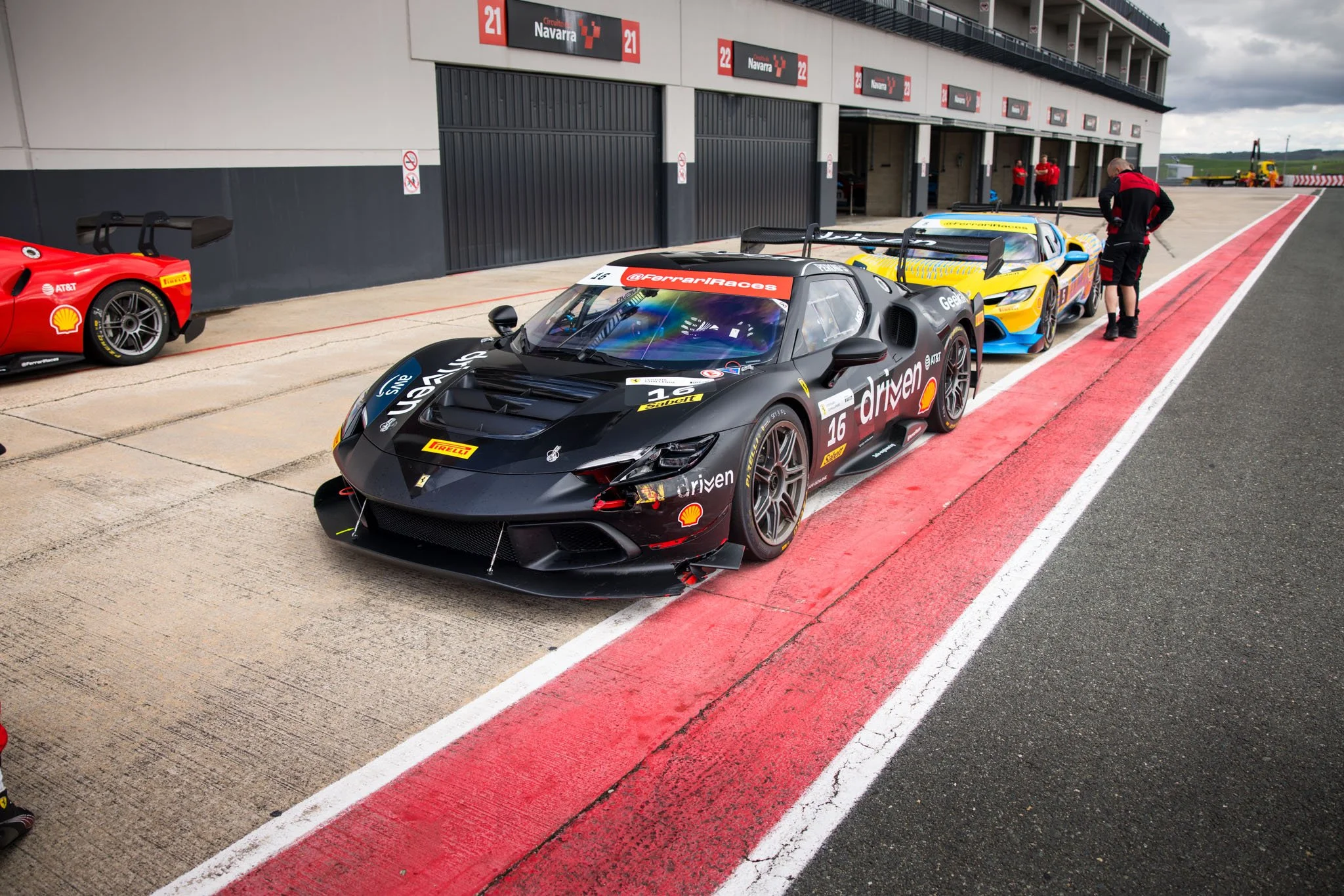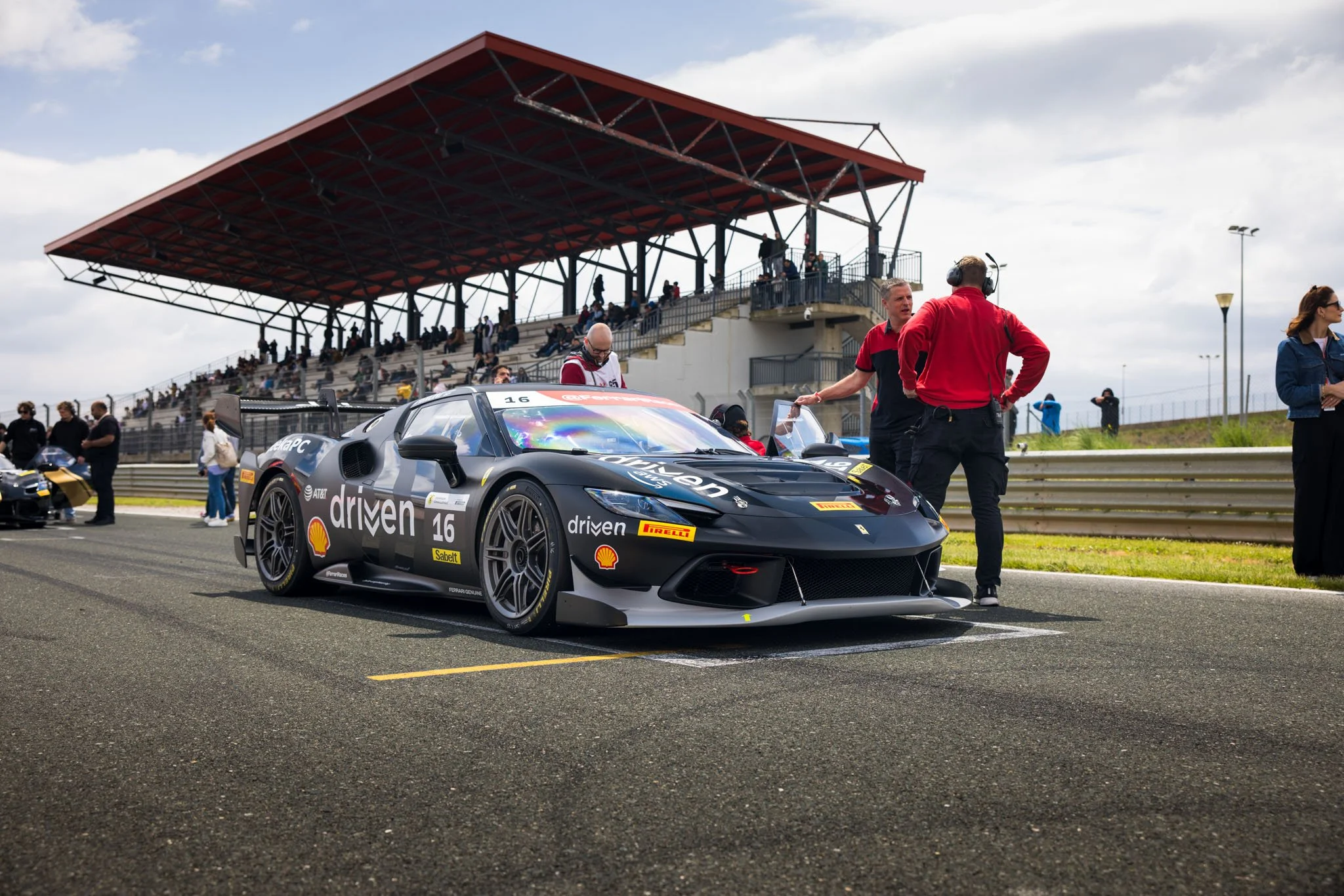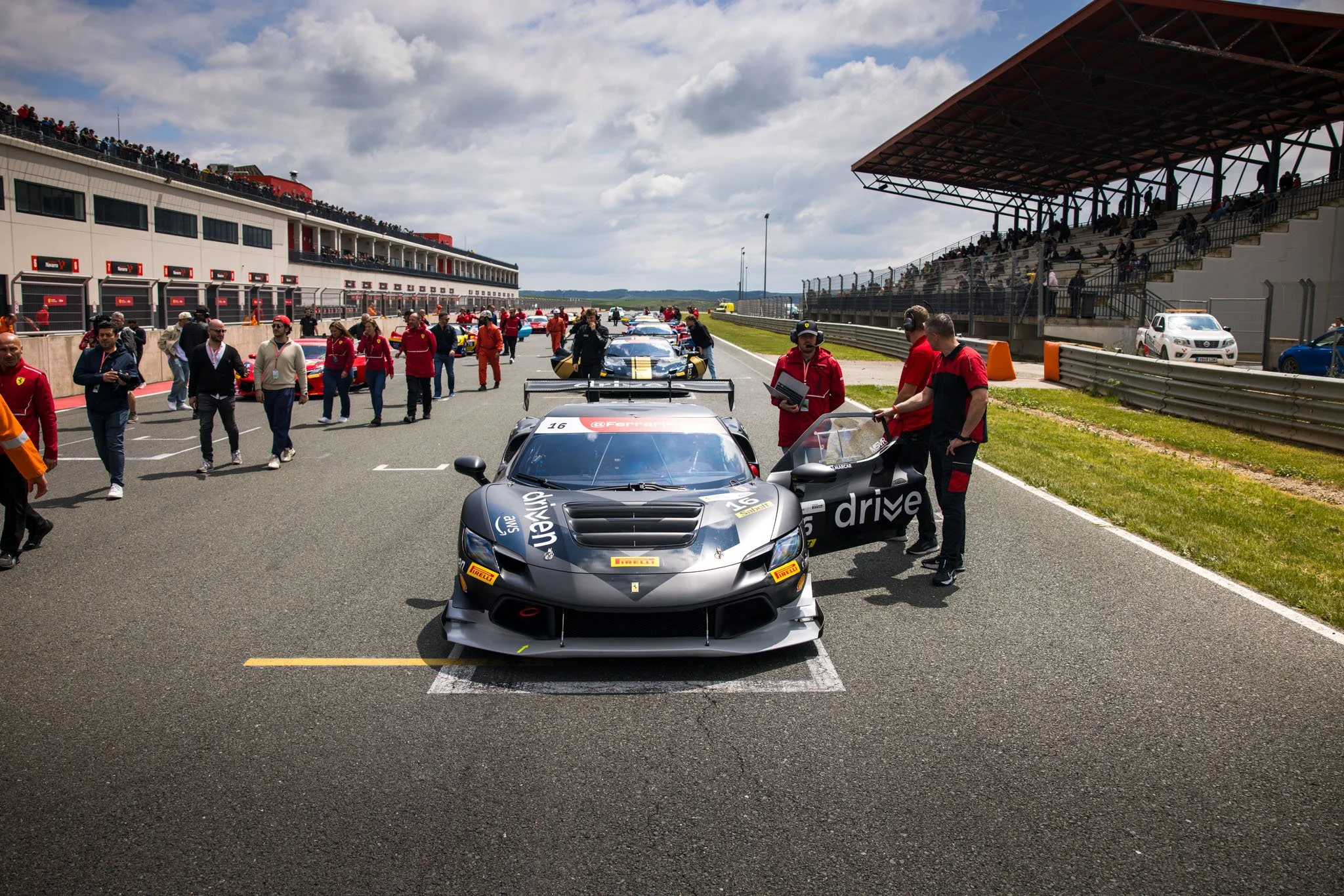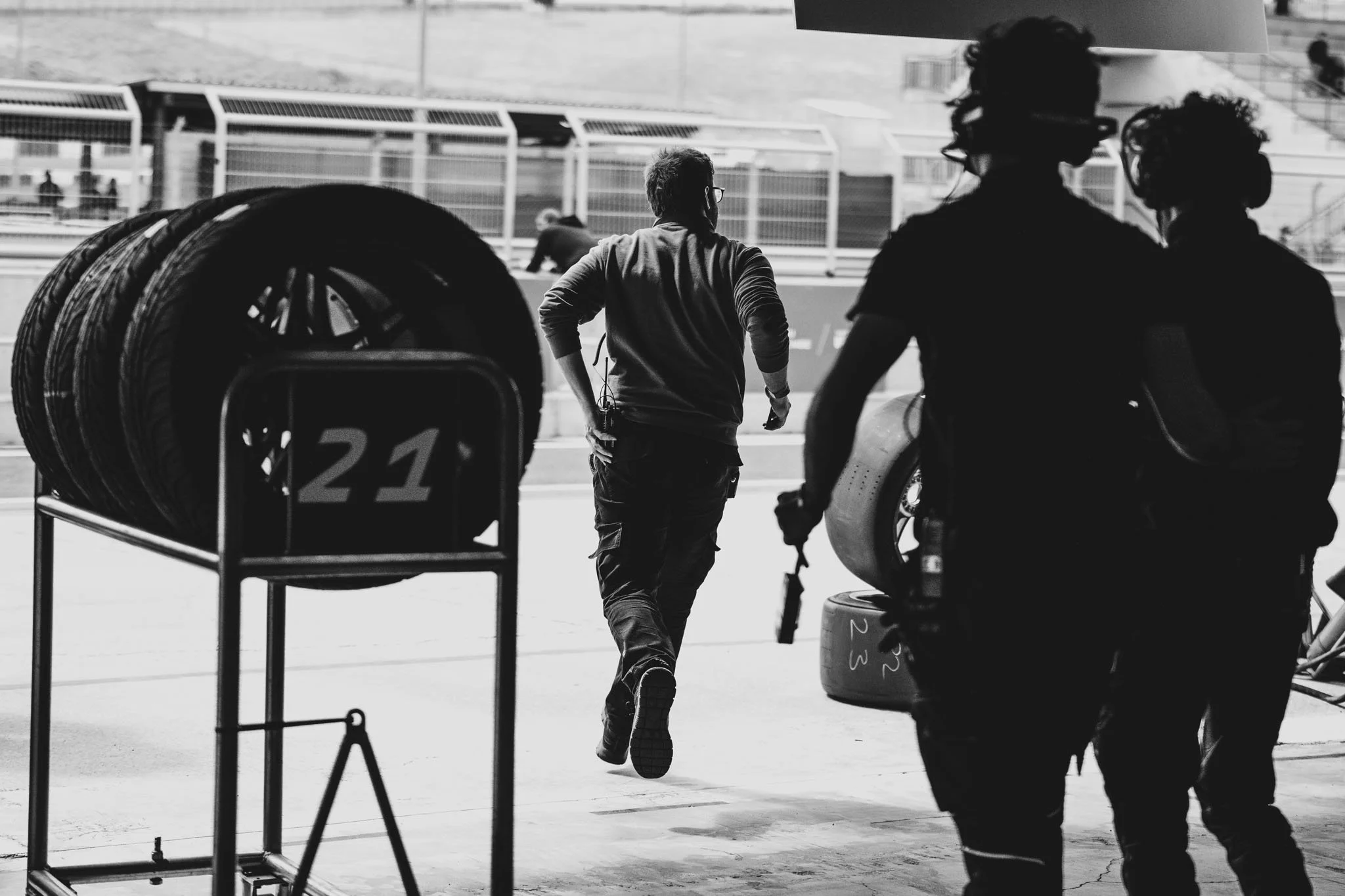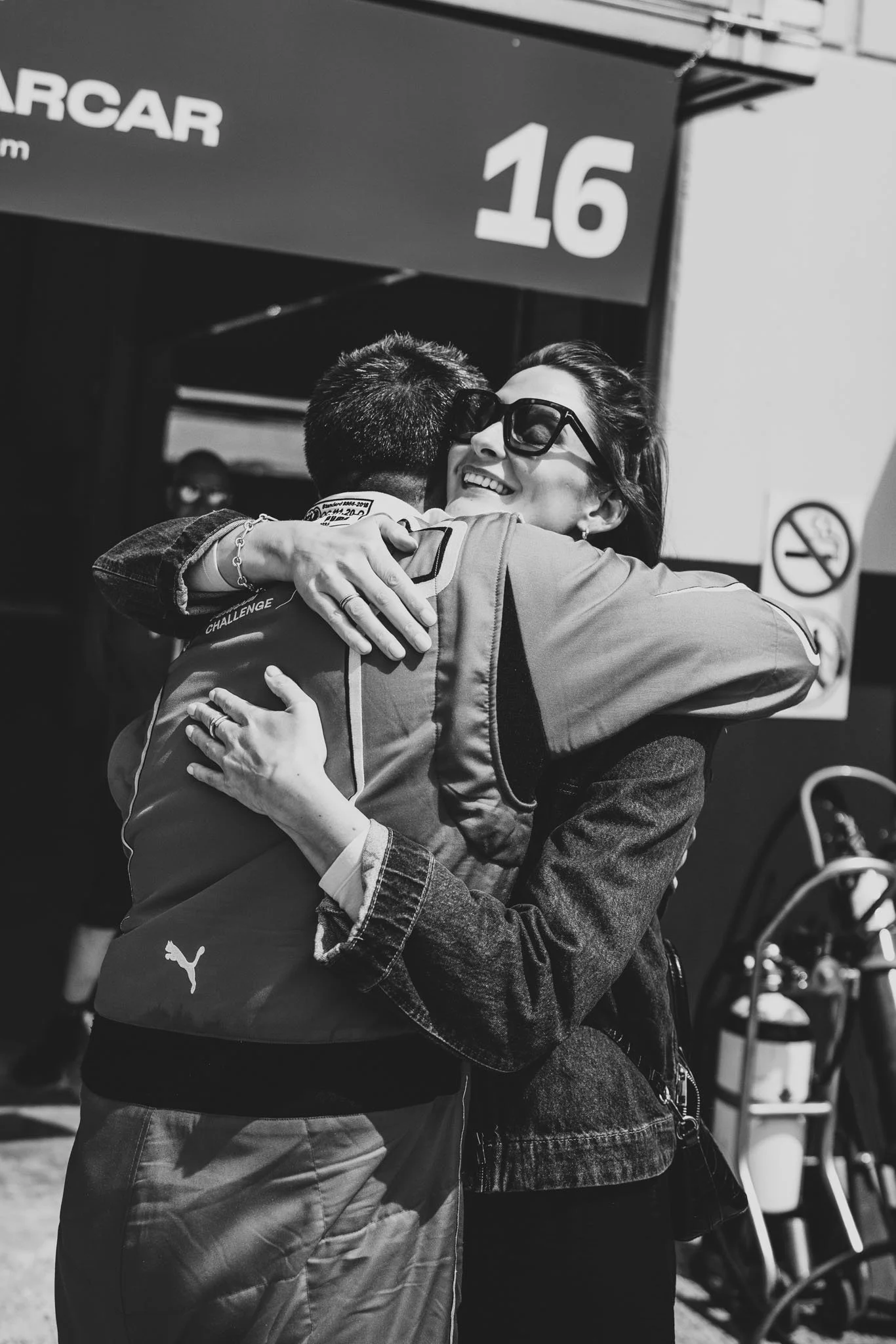John's Motorsport Diary: Chapter 4 - The First Race at Navarra
While sitting at my desk at home in leafy Warwickshire, I feel as if what I'm about to start writing about could be an amazingly vivid dream. And yet, the dull aches in my left shoulder, the camera roll full of images, and the screen-recorded video clips prove that it was all very real.
I've just returned from Northern Spain and my first ever race weekend in the UK Ferrari Challenge Series. The weekend had its highs and some lows, and above all else, it created some core memories that will stay with me for life.
Before we delve into the racing, though, we should pop back in time to the week before the race, which saw Miles Lacey and me flying out to Navarra for two days of testing just 10 days before the big weekend.
Welcome to Navarra
As I wrote about in chapter 4 of the diary, ahead of my first race, I had the opportunity to take advantage of a 2-day test day; this time, rather than at Silverstone again, it would be at Navarra the week before the first race. The testing I'd completed at Silverstone was primarily useful to learn the car. At Navarra, there would be a continued opportunity to master my new machine; however, far more importantly, was the task of learning the circuit.
Navarra is a new circuit to the UK Ferrari Challenge Series, having recently been purchased by multi-UK circuit owner Jonathan Palmer and his company Motor Sport Vision (better known to most as MSV). Navarra is the first MSV circuit to be owned outside of the UK, and along with the initial purchase of the site, a sizable investment has been put into upgrading the facilities and local infrastructure in the hope of enticing new drivers to the region. As season openers go, it would be hard to beat. A glamorous international location, stunning surrounding scenery and a climate marginally warmer than that of most other MSV UK circuits in April.
Before flying out for the test, Miles and I had spent hours on the simulator back at the Driven office in Coventry. The simulator, whilst it'll never replicate the true sensation of speed and g-forces, is an invaluable tool for learning corners, circuit layouts and driving lines. We had spent enough time on the sim to be reasonably confident that we knew what we were getting involved with.
Image courtesy of https://www.circuitodenavarra.com/
An Unexpected Surprise
Having arrived in the gorgeous Basque region of Spain and the rolling hills of Navarra, we signed on for our first day of testing at the circuit and embarked on some 'sighting laps' in our little hire car before donning our race suits for the Ferrari.
Seeing the circuit in real life after many hours on the simulator is quite surreal. For both Miles and me, Navarra is new. When the race calendar was announced in the summer of '24, we both had to Google Circuito de Navarra because neither of us had even heard of it. We were quietly confident, though, after plenty of time on the simulator and some studying of other people's laps on YouTube, we 'sort of' knew which way the corners went and what to expect. That was, up until we turned around the 9th and 10th corners to discover an entirely new circuit layout, which was altogether different to the version of the circuit we had been driving and studying all winter on the sim. Que a simultaneous "oh" from the front of our little Cupra hire car.
Fortunately, the new layout, which consists of a new hairpin turn and adapted (for the better) right-left complex, was a welcome change as the previous layout had proven to be very challenging on the simulator.
Two Successful Test Days
The two test days, as expected, were invaluable for me, the car, our race engineers (Davide and Stephen), and Miles, who was also able to set some reference laps for me to work towards and give guidance through data and tuition between the test sessions. We ended the 2-day test feeling confident that we were in a good place for races 1 and 2 of the season, which at this point were just 10 days away.
Returning for the Race …and Learning Some Lessons
Just a short blink later, Miles and I were back in Spain—this time with quite the team around us. We had additional support from the Hands family (Phil, the owner of the car and his wife, two sons and their partners). We also had our media team with us, consisting of Alex Goy and Henry Faulkner-Smith, and crucially, my partner Amie was by my side, who was about to experience her first ever motorsport event. Arriving back at the circuit ahead of the race was extremely exciting. What had been just a few trucks and utilised pit garages for testing the week beforehand was now a Ferrari complex with a full hospitality building complete with a kitchen and restaurant erected just for the event. Each garage was now dressed with Ferrari-branded cladding, which housed large screens to monitor lap times and live feeds, and there was even a dedicated changing room for drivers. On the morning of the test, all drivers were invited to collect their race wear and apparel for the season, encased, of course, in a Ferrari-branded Puma hard-shell suitcase.
In addition to my new Ferrari race suit, new Puma racing shoes and gloves, and a collection of lovely Armani loungewear, I also had something else shiny and new to wear—a freshly custom-painted Arai GP-7 racing helmet. I'm a true brand advocate for Arai helmets. I only wear Arai when riding motorcycles, and even have an Arai open-face helmet that I've previously used for track days back home. Upon learning of my involvement in the UK Ferrari Challenge Series, Arai kindly provided me with a brand new GP-7 for the season, which comes as standard in plain white–a blank canvas if you will. Having corresponded with the talented team at Image Design Custom, who are world-famous for custom paint jobs on crash helmets, my plain white Arai matched my car's colour scheme. I officially had all the gear and... some idea.
Lesson 1: How to avoid the dreaded gravel trap
The Friday test day before the two-day race weekend was a great final test opportunity for dialling in driving lines, perfecting cornering techniques, and working on getting some times. But, toward the end of the day, I would learn a lesson from the sort of mistake you only make once in your motorsport career.
For my last test session, I went out on a new set of tyres. I completed a couple of laps to bed in the new slicks, building up temperatures with firm but gradual acceleration and braking patterns - we call this 'tyre installation laps'. Because of the importance of not wanting to lock up the tyres under brakes, I switched the ABS setting to a higher setting, level 2, which helps reduce the risk of locking the wheels and damaging the new tyres when building up heat. Once the installation laps are complete, it's a case of switching the ABS settings back to level 1 and pressing on. Around seven laps into my session, I was given the order to start pushing for times, which I did. The car was feeling good, and the lap times were looking consistent. But then, as I entered the new complex of the circuit braking for the new hairpin of turn 11, I clipped the inside curb, which unsettled the braking, and despite a hard push to the floor with the brake pedal, the car simply wasn't slowing. I left the circuit in a perfect straight line and landed in the gravel with a crunch. Luckily, the excursion into the gravel did not harm me or the car, but there was no way out without the help of a friendly local marshal, a Mitsubishi Pajero and a tow rope.
As I sat in silence with the engine off, waiting for the marshal, I radioed through to Miles in the garage. "I'm off. I've landed in the gravel. Not entirely sure what I've done there..." and just as I said that, I looked down at my ABS setting to see that I'd forgotten to switch out of setting 2 from the tyre installation laps and back into 1. It was 100% my error, a silly mistake and luckily a lesson learned in practice rather than a competitive race or qualifying session. With only half an hour remaining of the day, that was me done. I was pulled out of the gravel, and I drove the car back to the pits, accompanied by the soundtrack of many hundreds of stones falling from the undertray and pinging off my tyres. I must have apologised to Stephen, our car technician, at least 20 times, as I knew he'd have to clean up after my mistake. I returned to my hotel with my tail slightly between my legs and a new level of nerves for the two races I had coming up over the following two days. It was now all starting to feel very real.
Saturday 26th April - Race Day 1
I returned to the circuit and found the car in the garage with Stephen beside it. I apologised again at least another 5 times about the gravel clean-up operation, and he insisted it was fine. Crucially, there was no harm done to the car. I was terrified that I might have damaged the brake disks by trapping stones between the pads and discs, but luckily everything was fine.
Polite pleasantries over, it was time to suit up again and prepare for some final practice laps before qualifying on a new set of tyres and setting a time for a position on the grid.
Lesson 2: How to Qualify
The practice laps put any concerns at rest; the car felt great. Before long, it was time to prepare for the qualifying session, a time slot of just 20 minutes to bed in a new set of tyres, set the fastest lap possible, and determine the position on the grid. I double-checked and then triple-checked my ABS settings, went out to install in my tyres, and pushed for a time. Twenty minutes might sound like a lot of time, but with each lap taking around 1 minute 50 seconds to complete, it soon flies by. Just as I started to feel comfortable and find my flow, I saw a chequered flag. The session was over in what felt like 5 minutes. I knew I hadn't beaten my best time from practice, but it was enough to put me in 5th place on the grid for the race.
While time seemed to speed up for the qualifying session, it stood still between the qualifying and racing. Around 2 hours separated the two activities, and the nerves started to kick in as the time grew gradually closer.
Race 1
Around 15 minutes before the scheduled race start time, Miles instructed me to get into the car and start preparing, which I did, and then my focus became the task at hand. Two parade laps occur before the cars get into their grid positions, allowing some time to put heat back into the tyres. The tyres used for the race are the same set used for qualifying, so while they're nicely scrubbed in, they were now cold and in need of heating up to make them soft and sticky again.
With the two warm-up laps complete, it was time to stop on the grid in position for the race. With Miles' guidance through the car's radio comms system, I found my marker on the grid and parked. While all the cars sit on the grid, a 'grid walk' involves team members, friends, and family walking between the cars and encouraging the drivers. I shook a few hands through the open door and waved at Amie, my partner, who looked as nervous as I felt. And then, in no time at all, the grid was clear of people and left with just the cars.
All Ferrari Challenge races commence with a rolling start, which means the cars depart the grid in the race order following a safety car for one formation lap before starting the race at pace. The formation lap allows some time to put more heat into the tyres and brakes. Towards the end of the formation lap, the safety car returns to the pit lane and the cars get back into formation as they roll towards the lighting gantry.
A wall of red lights shines brightly as we all roll towards the start line, and then, in a bizarre few seconds of silent focus, the lights go out and the cars roar into life. We're racing.
'This could get messy!'
Before the race, I had one big primary concern. The first corner complex after the start finish straight - turn 1, 2 and 3. In practice, it was complicated. Flaout fast into the first turn, hard on the brakes through the second and slow to a crawling pace to get through turn 3, which was almost a hairpin. For the race, on top of the complexity of getting through the section, there are now 20 other cars all trying to do the same thing whilst fighting for position. I was convinced that some cars would come into contact with each other by turn 3, and yet, in the moment, we all got through.
Once I'd made it through the first lap, I couldn't possibly tell you what position I was in; at that moment, it didn't matter. I was racing in a Ferrari at Navarra, and it was all starting to feel very special. After 5 minutes of racing, a few cars had come off I was aware of a car spinning to one side at corner 12, but my focus was on safely getting by. Elsewhere on the circuit, another car had made contact with a barrier at turn 17, requiring the safety car to come out and control the race until it was cleared up. The safety car allowed the grid to reform in close quarters once more. Great for those hoping to fight back through positions, but not so great for those who had fought for a strong lead or gap between the other cars.
Once the stricken car had been moved back to the pits, the safety car was called back in and the race resumed. I found myself fighting for a position with car 88. I knew I was quicker, so I started thinking about where I could get past him. With equally frustrated cars behind me, I knew I needed to make a move. After a lap of watching and thinking, I decided that an opportunity may arise at corner 9, a section of the circuit that I was confident in.
Lesson 3: Risk vs Reward
As we slowed from the back straight into corner 9, I noticed car 88 was staying left, which I interpreted as a gesture to let me pass. But as I went to the right of the slower car and inward toward the apex, car 88 darted right. His rear right wheel collided with my front left side. There was a crunch, and bits of plastic shot off the car. I was horrified. I immediately thought about the worst-case scenario - have I broken the steering or suspension? I quickly realised that the car was steering straight. I radioed it through to Miles. "I've hit another car; he turned into me. The car feels okay, but I've taken some damage." Miles instructed me to keep at it and keep monitoring. In the commotion, the two cars fighting to get past me from behind did precisely that and found their way through at the time of the impact. I was annoyed.
I continued and finished the race feeling a bit deflated and annoyed that I'd had the collision and caused damage to the car, although the extent of the damage was unknown. I crossed the line in 7th place in class (10th overall) and entered the pits, where the team met me. I climbed out of the car and told the mechanics and the team my side of the story.
I should have been elated, I'd just finished my first race, but I wasn't happy. I wanted to find the driver of car 88 to discuss what had happened. I honestly didn't know if it was my fault or his. But he was nowhere to be seen.
"I'm sorry, I didn't know you were there"
It was only whilst assessing the scenario that I realised something sombering, car 88 was the car that had spun towards the start of the race at turn 9. At the point of colliding, he was a back marker in 16th place, a whole lap behind everyone else, with no blue flags being waved by the marshals to allow the faster cars in competitive positions through. I'd been fighting for a position unnecessarily and, as a result, had caused cosmetic damage to the car. To add insult to injury, when I found the driver of car 88, he apologised and said, "I didn't see you. I didn't know you were there because I didn't look in my mirrors."
As first races go, it was eventful. But it was a finish, and that matters for something. Like so many of the experiences at Navarra already, it had been a learning opportunity, and a sit-down with Miles the following day to look through the footage on the VBOX would cement that theory.
Sunday 27th - Race Day 2
On the evening after race 1, Stephen, our technician, had once again been hard at work on repairing my car. Friday night had been an evening of removing gravel, and Saturday night was spent replacing the broken plastic parts shattered in the collision. I arrived in the garage on Sunday to see a replacement front splitter on the car. It was finished in primer grey and stood out like a sore thumb against the rest of my satin black wrap. A new headlight also replaced the one that had been shattered in the incident. I'm yet to find out the cost of the replacement parts, but I can't imagine it's what many of us would class as cheap.
Race day 2 had a slightly less hectic schedule. There were no practice sessions, just qualifying and then the race. I went out to qualify with a better expectation of session times. I installed the new tyres and succeeded in qualifying with a laptime of 1:47 - I'd found an entire second of improvement, which I was pleased with, but I discovered that pretty much all other drivers had done the same. I qualified 6th, which was still good; all I needed to do now was get through the first sector in the race and then have a nice clean run in the hope of a better overall position.
Lesson 4: ‘Patience is a virtue’
Before the race, Miles and I sat down to look through the data from race 1. Data review is crucial as it can help make sense through analysis of mistakes, missed opportunities, and occasional positives. There was one very vital talking topic that needed discussing—the incident. Miles had spent the evening before working through the footage and had made his conclusions and some very comprehensive notes. What I'd done was risky, and to give it a better word, was a bit stupid. I'd been too greedy with my move; the overtake I'd gone for wasn't mine to claim. Sure, car 88's lack of awareness wasn't ideal, but equally, as an overtaking driver, it was down to me to time it right and get by safely. I hadn't done that, and that's what caused the collision. The lesson to take away was 'patience'. "If you know you're faster, hold the line, wait for the mistake and get by when the time is right. Don't rush it." That was the line from Miles that stuck firmly in my mind.
Race 2
An hour or two later, I was back in the car and on the grid, with the hustle and bustle of the grid walk happening around me. Just as it did in race 1, the grid clears of people, the formation lap starts, and once again, I'm hurtling towards the lighting gantry in my 6th place qualifying position, feeling nervous about the first three corners. Lights out, we're off, and once again, everyone gets through sector one without any incidents - phew. As the lap continues, though, battles are happening all around me. At the end of lap 1, two cars come together, sending one off the circuit to the left on the start finish straight (and into retirement) and another with half a bumper flailing off the back. I managed to stay out of trouble and find my rhythm.
Miles spoke to me on the radio, giving feedback on the lines. He can see GPS data showing positions of all cars on track and can help me identify who's fast and who's a backmarker. Around halfway into the race, I see the familiar rear bumper of car 88. My newfound nemesis from race 1, only this time, he's not a back marker, he's driving for a position, 4th position, and I want it.
Two laps pass with me watching his every move. I'm looking for mistakes and opportunities where I can safely get by. As I'm calculating, Miles appears on the radio again. "Wait for him to make the mistake; you are the faster car, and the time will come." Miles was right, I had to be patient. I didn't want to cause any harm to my car or his, it was just a matter of time. Just like in race 1, I could see traffic building behind me; there were other drivers equally keen to get past car 88 and, at that moment, past me too.
The pressure of multiple cars behind me, whilst I want to overtake a slower car ahead, is immense. It feels like being stuck in limbo - a sort of frustrated car sandwich in which I'm the main ingredient. I had noticed that car 88's cornering was starting to get scrappy - an opportunity had to come soon. In the complex of turns 5 and 6, I saw a gap and went for it. By the time I was alongside car 88, I was overtaking on the outside line of turn 6. It was a risky move, but there was no going back. I pushed, got around on the outside and then tucked in tight to the inside for turn 7. I was clear. I'd got by.
The Overtake:
(clipped from YouTube)
I got through turn 8, and I was gone. I could see an immediate gap in my mirrors, which felt fantastic. It proved that I was the quicker car and that the overtake was justified. I was now in 4th place and couldn't have been happier. The top 3 cars were long gone - far ahead and rightly so, their qualifying times were at least a second faster than my best time, so the chances of my catching them were extremely slim. I was okay with that, I just wanted a clear, clean finish. I squeezed past a couple more backmarkers who were now a lap behind, and everything felt good. The tyres started to feel pretty knackered just as Miles came through on the radio to tell me 4 minutes were remaining in the race. I just had to carry on doing what I was doing and bring the car home, simple! ...And then a nightmare scenario unfolded.
The Puncture
As I flew down the start finish straight and into sector one with 3 minutes of the 30-minute race time remaining, a bright yellow alarm flashed on the dashboard 'TPMS' (Tyre Pressure Monitoring System) - I'd seen this alarm once before on a test day. It had indicated a puncture. The dashboard screen was showing that my rear left tyre was deflating. I was heartbroken. I immediately started considering the idea that I'd have to retire with a DNF (did not finish). I radioed it through. "Guys, I have a TPMS alarm. Rear left. It's a puncture." There was no immediate response. I continued driving the car, feeling the handling starting to deteriorate from the rear. Miles returned to me on the radio comms, "Okay John, keep monitoring it, we're ready for you if we need to be, but you're on the last lap now, so see if you can just keep going". The internal dilemma in my mind was chaotic - can I really keep going with a puncture? Is the tyre about to go flat? Might the tyre come off the rim?
I noticed that the tyre, whilst undeniably deflating, was doing so slowly. At this point in the race, the outer layer of rubber on the tyres is almost a liquid. The rubber has melted to its stickiest, hottest point, and as a result, can self-heal any small holes, which most likely came from running over some damaged debris.
I approached the finish line looking for the chequered flag - but it wasn't there. 'Where was the flag? I thought I was on the last lap!' Miles returned on the radio. "Okay, John, this is the final lap. Do what you can to finish the race". I had a gut-wrenching feeling in my stomach. How am I going to get around an entire lap with a deflating tyre without either losing control or losing the position I'd fought so hard for?
I could see car 88 and others reappearing in my mirror behind. They were catching up, and there was no way I'd be able to drive at the pace I'd previously set. I remember feeling so disheartened. 'This is all going to end in tears,' I thought to myself. Yet by some miracle, I was still holding my position at 3/4 of the way around the final lap. The tyre pressure on the screen was now showing 0.5 bar - that's as good as flat, and the rear end felt dangerously loose. I fought the car around turn 15, holding car 88 in place, and got through 16 before the final turn, turn 17, which is a slower turn before the straight. I held the line, got the car around, and 88 was still behind me. I could now see the chequered flag and was across the line within a heartbeat. I'd held 4th place and finished the race with two entire laps of a deflating tyre.
I hit the radio button on the steering wheel to talk to Miles. "Thank f**k for that!". In a moment of relief and partial disbelief, the emotion overwhelmed me as I came to terms with what I'd achieved. I had tears rolling down my face. Just moments before, I firmly believed that my race was over. There was simply no way I could finish.
I returned to the pit lane from the closing lap with the tyre TPMS screen showing 0.0 bar on the rear left tyre. It was now completely flat.
It all ended in tears (fortunately, the right kind)
Now, I'll be honest with you, reader, if that race had ended with a retirement or worse, I'd have really struggled to admit that I'd enjoyed my first weekend of racing in a Ferrari. But by chance, with some luck, a bit of skill, and some expert guidance from Miles, it all worked out. I'd proved to myself that I'm not totally useless in a racing car, which was a much-needed realisation reward.
I finished 4th in class, just one spot off the podium for my second-ever race, and that was fine by me.
Next up in the diary is Oulton Park, back home on familiar turf in the UK. I guess we'll have to go and do it all again. See you there?
Join me at the Oulton Park Race: https://www.oultonpark.co.uk/2025/may/ferrari-challenge-uk
words by John Marcar
photography by Henry Faulkner-Smith & Miles Lacey (Helmet shots)
video feeds from the Ferrari UK YouTube Channel
Special thanks to Arai and Image Design Custom
_____________
John Marcar's Ferrari Challenge Diary:
Prologue: ‘Welcome to the diary’ >> READ HERE
Chapter 1: 'Ready 2 Race'>> READ HERE
Chapter 2: 'Let's Start Off by Winning'>> READ HERE
Chapter 3: 'My First Official Test Day' >> READ HERE
Chapter 4: ‘The First Race at Navarra’ >> (YOU’RE HERE)
_____________

